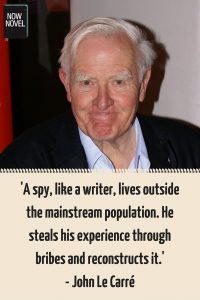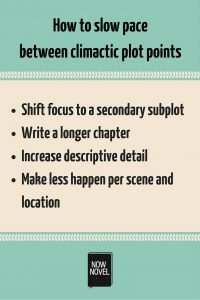What is pacing in writing? In fiction, pacing refers to how quickly (or slowly) the action of the story unfolds. Why is pacing in a story important? Because it helps to keep the reader interested and maintains a desired atmosphere and tone. A suspense thriller shouldn’t move at a crawl, just as an adventure novel shouldn’t end rapidly, almost as soon as it began. Here are 5 tips for getting pacing in your novel right:
1. Plan the rise and fall of your novel’s plot and action
Outlining your novel helps with pacing because you can see at a glance where there is concentrated action or eventfulness and where there is a lull. Sometimes there might be too long a lull in one place and too much action crammed into another. Spread out fast-paced, exhilarating moments of peril and adventure and your characters’ more mundane activities. The reader shouldn’t say ‘this happened way too fast’ or ‘that part really dragged on forever!’
2. Think of your novel pacing in structured units
Think of your novel in terms of scenes (sections that contain a single important plot event or character interaction) or larger units (such as acts, as She’s Novel does in their post on pace and storytelling). These larger units typically have distinct degrees of pace.
For example, in the basic ‘three act structure’ borrowed from theatre, there is an opening, middle and end to the story. Typically, the first act introduces readers to the central conflict that your story will resolve. This could be anything from an inexplicable disappearance (such as the disappearance of a cat in Haruki Murakami’s The Wind-up Bird Chronicle) to a character’s inner conflict about themselves.
The middle act of your novel is where you develop this central conflict and help the reader understand its origins and the direction it might lead your character(s). The final act brings the conflict to a head and (usually) resolves it.
Each of these sections of your novel will have different pacing. The first act usually doesn’t dawdle and take its time, as you want the reader to be lured in. The middle act is where you can push and pull pacing more. If in the first act your protagonist (main character) is struggling with a desire to kill, the middle act can show him slowly giving in to (or overcoming) this urge. There can be moments of calm and moments of high tension.
In the third act, though, the pace usually increases as tension builds. The cracks have started to show in your main character’s personal life – he can no longer keep his bad deeds a secret. The stakes increase and the reader wants to know how it will all end.
To make the pace move at the correct speed in each of these larger structural units, think about the purpose of the section. If you want to grip the reader, use conflicts and move your characters from setting to setting to create a sense of momentum. Similarly, if you want to give the reader some respite before the major climax, you can slow your story pacing and lessen the conflict and tension for a while.
3. Hone your book’s pacing by reading the greats
Even if thrillers and spy novels aren’t your preferred genre, read bestsellers who have mastered pacing such as John Le Carré. This will help you to understand how to make your plot ebb and flow engrossingly. Even though most of Le Carré’s protagonists are embroiled in internal rather than external conflicts, the writer masterfully unfolds these struggles at a pace that isn’t leisurely but also isn’t mechanically hurried.
To learn story pacing from great authors who are celebrated for their own command of it, make notes as you read on pace. Note elements such as:
- Any reference to time in the course of the book
- How many pages each chapter is
- Why the shortest chapters are short and what effect this has on the sense of momentum
One way to master pacing is to understand how the elements of language – sentence structure, for example – affect the pace of your story:
4. Use sentence structure to manipulate pacing in writing
Pacing in writing is affected by sentence length. Think about it. You’re reading this faster. There are fewer words. The sentences are simpler. When you want the reader to feel events are coming to an important climax, shorter sentences can be effective. Compare the following two paragraphs:
The abandoned-looking building stood foreboding in the dusk and we snuck around the side, minding the cameras that swivelled out front. I froze when I heard a man’s voice through a plastered-over window. ‘We need to find new headquarters,’ he hissed.
Compare the pace of the above to this alternative:
The building looked abandoned. Foreboding. Cameras swiveled out front so we decided to sneak around the side. Suddenly a man’s voice hissed through a covered window. ‘We need to find new headquarters’.
The second keeps the pace moving, not getting lost in lengthy sentences and detailed descriptions. Of course, you could also keep your writing descriptive until the conversation starts and then alter the pace, to create sudden tension. These are the choices you will need to make regarding sentence structure: Where will the story start to move? Where will characters sit back and admire the scenery?
5. Slow your story’s pacing down with focus shifts, detail and longer chapters
It’s very seldom that a novel hurtles along without the occasional strategic pause that allows your characters (and your readers) to gather their thoughts. There are several ways to slow down your story in strategic places. You can reduce the pace of a story by:
- Shifting focus to a secondary subplot (more on this here) for a while to take the heat off your main story line
- Writing longer chapters
- Being more generous with extra descriptive detail
- Making fewer things happen per location or scene
A great novel has balance: Some scenes hurtle along while others dawdle and meander. Some genres have more of the hurtling (such as thrillers) while others more of the dawdling (many character-driven dramas and romances). Whatever type of novel you’re working on, getting pacing in writing right will keep readers entertained and committed to finishing your book. And if you’re writing that shorter cousin of the novel, a novella, remember pace is as important, but the pace will likely to be quicker.
Start working out the details of your plot now using Now Novel’s step-by-step book-writing process.




5 replies on “What is pacing in writing? Mastering pace”
I am writing a community driven story called Aetherian Wars at http://aetherianwar.webs.com. Four sides, four stories, and one end. You as the community decide Where we go next in the world.
Very cool idea!
How does this apply to a trilogy? I have more of an “Act one” part in the first book simply because it will take a lot of explaining and understanding of the characters to understand the rest of the books.
Your trilogy may have one long story arc, but the rules still hold true for every book in the trilogy. Each book has to be able to stand alone as being worthwhile to read, and in doing that the portion of the story that is covered in the first book still needs to have the right pacing and excitement (which is why we recommend the three act structure)
The challenge for you will be to find self contained pieces of your story that can easily be segmented into the trilogy. I can also imagine that introducing each character in detail is not crucial at the beginning, as different characters play more important roles at different stages of the story.
Good luck
[…] Bridget McNulty. NowNovel.com. “Pacing in Writing:” https://www.nownovel.com/blog/pacing-in-writing-5-tips/ […]